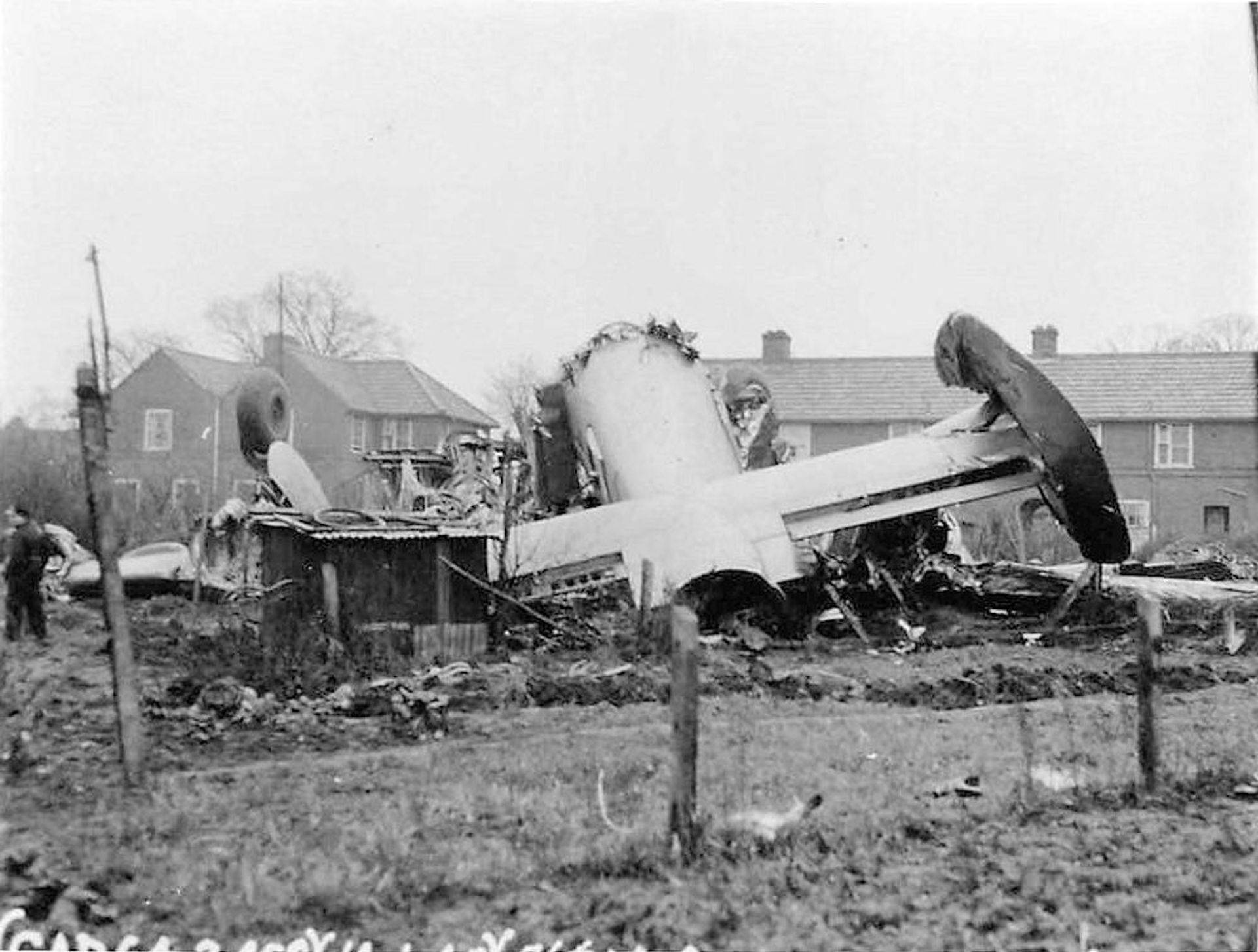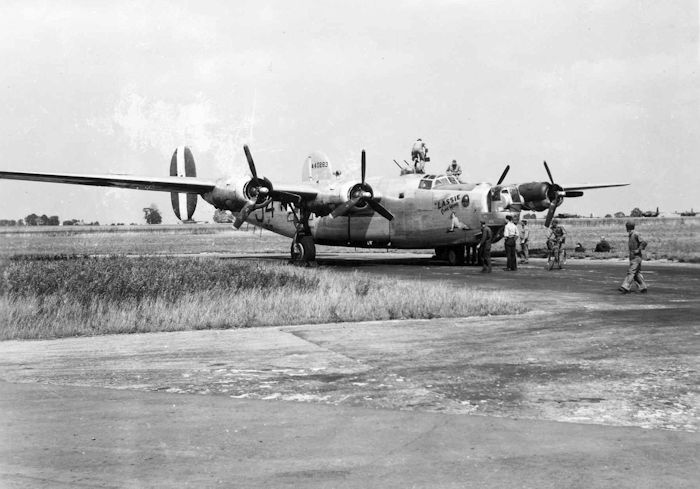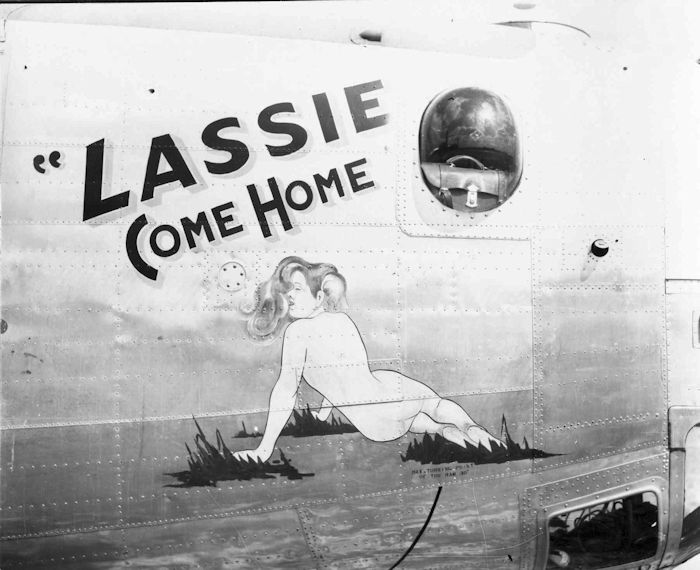458th Bombardment Group (H)
Lassie Come Home
B-24JAZ-155-CO 44-40283 J4 I

Crash Spynke Road, Norwich – January 14, 1945 (Battle Damage)
Lassie Come Home was an original AZON ship, arriving at Horsham St Faith at the end of May 1944. Flown to England by the Lt Tracy crew, they were able to fly “their” aircraft on the first few AZON missions. When that project was abandoned in August, the ship was made available for regular bombing operations. The Tracy crew flew Lassie Come Home on another eleven occasions over the Continent, having to abort one time – the only aborted sortie for this aircraft’s 29 missions.
Excerpt from Liberators Over Norwich
On January 14, 1945 the 458th targeted the marshaling yards at Hallendorf, Germany. Flown by 2Lt Stanley E. Diehl and crew from the 753BS, Lassie Come Home did not quite make it back to Horsham. They were, “…heading in over the northern city outskirts on landing approach with flaps and landing gear deployed. One engine was already “feathered,” but what was already a tricky situation turned lethal when a second engine on the same wing also went “out.” The bomber faltered under the drastic power loss, and the engine pitch of the two functioning engines was heard to rise in desperate cadence as the pilots applied power in a bid to stabilise the situation. Their efforts were in vain, as the bomber sharply inverted and plunged into the back garden at 14 Spynke Road, where it disintegrated. Seven regular crew members, along with two children, were killed. Two Crew members, S/Sgts. Norton A. Lawson (TG) and Robert H. Wehrkamp (G) came through unscathed, while 2Lt. Leo Hecht had replaced Lt. Harold W. Blanshan as co-pilot. Although Nos. 12 and 14 were marginally damaged by the bomber’s final onrush, it was still a miracle that further casualties were not incurred among the civilian population, since the crash site was bare yards away from the extended row of houses.”
Missions
| Date | Target | Pilot | 458th Msn | Pilot Msn | RCL | Sqdn | A/C Msn | Comments |
|---|---|---|---|---|---|---|---|---|
| 08-Jun-44 | UNSPECIFIED TARGETS | TRACY | AZ04 | -- | I | J4 | -- | ABANDONED - WEATHER |
| 14-Jun-44 | 5 TARGETS | TRACY | AZ06 | 1 | I | J4 | 1 | |
| 15-Jun-44 | 3 RAILWAY BRIDGES | TRACY | AZ07 | 2 | I | J4 | 2 | |
| 22-Jun-44 | Saumer, Tours - Tact Bridges | TRACY | AZ09 | 3 | I | J4 | 3 | |
| 01-Sep-44 | RAVENSTEIN, HOLLAND | CURLAND | AZ14 | 2 | I | J4 | 4 | |
| 10-Sep-44 | ULM M/Y | EVANS | 125 | 18 | I | J4 | 5 | LEAD 2ND SQDN - BREVAKIS |
| 07-Oct-44 | MAGDEBURG | TRACY | 130 | 22 | I | J4 | 6 | |
| 09-Oct-44 | KOBLENZ | BECKSTROM | 131 | 1 | I | J4 | 7 | |
| 12-Oct-44 | OSNABRUCK | AKIN | 132 | 2 | I | J4 | 8 | |
| 14-Oct-44 | COLOGNE | TRACY | 133 | ABT | I | J4 | -- | ABORT - RADIO COMP MALFUNC |
| 15-Oct-44 | MONHEIM | TRACY | 134 | 23 | I | J4 | 9 | |
| 26-Oct-44 | MINDEN | HADDEN | 138 | 5 | I+ | J4 | 10 | |
| 30-Oct-44 | HARBURG | GLAGOLA | 139 | 27 | I | J4 | 11 | |
| 02-Nov-44 | BIELEFELD | TRACY | 140 | 25 | I | J4 | 12 | |
| 04-Nov-44 | MISBURG | FUSON | 141 | 27 | I | J4 | 13 | |
| 05-Nov-44 | KARLSRUHE | TRACY | 142 | 26 | I | J4 | 14 | |
| 06-Nov-44 | MINDEN | FUSON | 143 | 28 | I | J4 | 15 | |
| 08-Nov-44 | RHEINE | TRACY | 144 | 27 | I | J4 | 16 | |
| 09-Nov-44 | METZ AREA | FUSON | 145 | 29 | I | J4 | 17 | SEE OPS REC - POSSIBLE ANA |
| 10-Nov-44 | HANAU A/F | TRACY | 146 | 28 | I | J4 | 18 | |
| 21-Nov-44 | HARBURG | BECKSTROM | 148 | 10 | I | J4 | 19 | |
| 25-Nov-44 | BINGEN | TRACY | 149 | 29 | I | J4 | 20 | |
| 26-Nov-44 | BIELEFELD | PISKIN | 150 | 31 | I | J4 | 21 | 8AF/K-21 |
| 11-Dec-44 | HANAU | VINCENT | 155 | 17 | I | J4 | 22 | |
| 12-Dec-44 | HANAU | TRACY | 156 | 31 | I | J4 | 23 | |
| 18-Dec-44 | KOBLENZ | TRACY | REC | -- | I | J4 | -- | RECALL DUTCH ISLE |
| 24-Dec-44 | SCHONECKEN | TRACY | 157 | 32 | I | J4 | 24 | WRITTEN "LAST MISSION" |
| 25-Dec-44 | PRONSFELD | TRACY | 158 | 33 | I | J4 | 25 | |
| 01-Jan-45 | KOBLENZ | SHANNON | 163 | 3 | I | J4 | 26 | |
| 03-Jan-45 | NEUNKIRCHEN | HICKS | 165 | 5 | I | J4 | 27 | |
| 07-Jan-45 | RASTATT | SHANNON | 166 | 4 | I | J4 | 28 | |
| 14-Jan-45 | HALLENDORF | DIEHL | 170 | 5 | I | J4 | 29 | BATTLE DAMAGE CRASH |
January 14, 1945

Norman Cooper of the Norwich Auxiliary Fire Service is visible in the tin hat at lower left.

Accounts
S/Sgt Henry F. Clayborn
In his search for more complete information on the death of his brother John (navigator), S/Sgt Henry F. Clayborn, U.S Army, on duty in France, obtained leave in March 1945 and made his way to Horsham St. Faith. He received a very warm welcome from the entire 753rd Squadron, especially the two remaining members of his brother’s crew, 2Lt Blanshan and Sgt Lawson. The following is an excerpt from a letter that he wrote to his sister-in-law, John’s widow Cleone.
“Until they were nearing the target everything went along as per routine. Then a flak burst damaged the number one engine on the left hand side seriously so that it was necessary to feather it. In addition the number two engine on that side started to smoke. Diehl was able to keep it going, however, and they were able to resume their position and make their bomb run. After they had unloaded their bombs, of course, they were unable to keep up with their regular formation and were forced to fall back. Eight fighter planes remained with them to provide protection from enemy fighters. The distance to England or Belgium at that time was equal and Diehl took an inter-phone vote among the crew members as to which spot they would head.
“Unanimously they voted to head for England. As they were now flying alone, as far as the bomber formation was concerned, the task of getting them there as fast as possible rested directly on Johnny. He was completely equal to the task. He gave them immediately an ETA (estimated time of arrival) of 3:28 PM at the Coast of England, and exactly at 3:28 they crossed the coast. His job had been done perfectly. Now everyone was relieved because the hardest part had been accomplished. They called the tower for priority landing and were granted the priority and completed the greater part of the circle on the field that is necessary for landing. As they were making the final turn it was necessary to bank into the left side (where the number one engine was feathered) and at the moment they were making the turn the number two engine cut out, leaving the left side completely dead. The force of the two right engines, of course, pushed the plane right over on its back and they crashed into a square of houses bordering the airport. Somehow, in that split second before the crash Diehl must have switched off the engines because there was no fire, although there was a lot of gas in all the tanks. Everyone in the plane was killed except Foggy and an extra gunner who had gone along.” – S/Sgt Henry F. Clayborn
Brian Breeze
“I was eight years old in January 1945, I lived with my mother in a bungalow a few hundred yards from the take-off runway at Horsham St Faith. My father was serving in the Royal Air Force. A school friend and I were watching the returning the B-24’s on that day having trembled with excitement and trepidation watching the same bombers clawing into the sky in the morning. We were used to seeing planes with smoking engines, pieces hanging off the various parts of the structure, flares being fired into the sky and a chaff falling down like tinsel. When it seemed like the last hand landed another ship came into sight, I do not recall seeing a propeller feathered or even if the wheels were lowered but it was an all silver coloured aircraft whereas most of the previous B24’s were a drab green even one being all black.
“Lassie Come Home seemed to be flying steadily and in a correct attitude that I was completely shocked when I saw the port wing drop and the plane seemed to throw itself head first into the ground. I was with a fellow boy of my own age and after gulping in what had happened he and I made short work of the distance riding our pedal bikes like crazy. We couldn’t miss the giant plane standing on its nose and leaning against a brick dwelling house. It was complete with wings and tail unit in place I recall the engines and the four part of the plane were in-bedded into the ground up to the leading edge of the wing. I am sure there must have been many people there but I didn’t notice them because it was strangely so silent. I expect at my age it was too much to take in and only the crashed plane was of any concern to me. We moved around the edge of the garden and on the pavement was a stretcher covered in a white sheet protruding out of one end were a pair of light brown boots and the other end a large area of blood as we stared at the sad sight we were told in no uncertain way to clear off in good old US dialogue.
“For some years it has bothered me as to why the tragedy occurred and whether any of the crew survived. We were unaware of any casualties on the ground as during the war years people didn’t talk much about the war especially to eight year old’s. It is probably of no consolation to anyone now but whoever shut down the fuel switches in the last seconds pilot or co-pilot is all kinds of hero, had there been a fire with fuel and ammunition exploding amongst the close packed houses it would have been a bigger catastrophe than it was already.” – Brian Breeze
Memorial Plaque

In 1995 a plaque was mounted on one wall of No. 14 and a dedication ceremony was conducted with Chaplain Wally Vaughn from USAF Mildenhall and the local British Legion, along with several other British veteran groups’ representatives in attendance. The names of all ten victims, along with the circumstances of their deaths, comprised the plaque’s tragic anecdote.
Additional Images
Scroll left/right for images
Disposition
B-24JAZ-155 CO 44-40283 LASSIE COME HOME
NMF
RCL: I J4 (753)
Original AZON aircraft. Lead aircraft.
Repaired at Braintree, Essex, 18 – 27 Aug 44 – # 2 engine.
Crashed 14 Jan 45 in the garden of 14 Spynke Road, Mile Cross, Norwich, on return. (Hallendorf) Salvaged 15 Jan 45.
(Info Courtesy: Tom Brittan)





